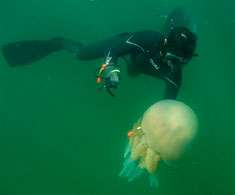Hunting jellyfish threaten fish stocks

Far from being at the whim of wave and tide, the enigmatic jellyfish has been found by new research to move deliberately in search of food – an ability that could threaten the future of other species already at risk from human activity like fishing.
A team of researchers led by Swansea University attached data-loggers to jellyfish off the Welsh coast, to monitor their vertical movements. The results suggest that these movements are deliberate and probably intended to maximise the creatures' chances of finding food.
Jellyfish adapt readily to changing conditions and can quickly increase in numbers to fill the 'gap' left by species in decline from over-fishing. The ability to deliberately pursue prey would give them even greater advantage over falling numbers of fish larvae looking for the same food.
"Everyone can recognise a jellyfish, but we don't know very much about how they spend their time," says Dr. Victoria Hobson of Swansea University, who organized the fieldwork and is co-author of the research report, published in the Proceedings of the Royal Society B.
"We have discovered they are actually quite proactive – they move independently and choose where they go," she explains.
The research team flew over Carmarthen Bay in Wales to find groups of the jellyfish Rhizostoma octopus. Operating from a boat, divers then loosely tied the data-loggers around the creatures' peduncle – the bit that joins the swimming bell to the arms; not an easy task with creatures up to half a meter in diameter and weighing up to 30kg.

The loggers took water-pressure readings every minute as well as measuring water temperature. The researchers retrieved the loggers as they washed up on the beach once the jellyfish had died, and downloaded the data. Of the 72 loggers deployed, 25 have so far been recovered.
Once the researchers had discounted non-intentional vertical movements, for example due to wave action, they could see how far and how often the jellyfish moved through the water column. They found that the creatures travelled on average around 600m vertically through the water each day, and were clearly not simply drifting at a fixed depth.
The pattern of movement was also similar to what's known as a Lévy walk – a foraging pattern thought to be adopted by certain animals to give themselves the best chance of locating scarce prey.
By examining the gut contents of several jellyfish the researchers could see that, however they were doing it, their foraging technique was successful, as the jellyfish stomachs were full of a variety of prey regardless of where and when they were caught.
Jellyfish are resilient creatures; they reproduce quickly and eat a wide range of prey, so they can adapt to changes in the marine environment that would pose problems for other species.
As over-fishing reduces fish numbers, jellyfish populations could increase, making the problem even worse because many fish larvae feed on the same plankton as the jellyfish.
The discovery of these complex and deliberate movement patterns adds significantly to our understanding of jellyfish behaviour. It also suggests they may be able to compete more strongly with fish then previously thought, making jellyfish even more dominant as oceans conditions change.
This story is republished courtesy of Planet Earth online, a free, companion website to the award-winning magazine Planet Earth published and funded by the Natural Environment Research Council (NERC).
More information: Graeme C Hays, et al. High activity and Lévy searches: jellyfish can search the water column - like fish. Proc R Soc B (2011), doi:10.1098/rspb.2011.0978
Provided by PlanetEarth Online

















